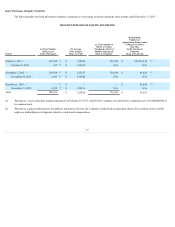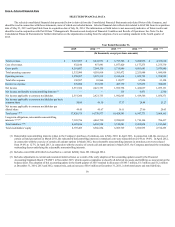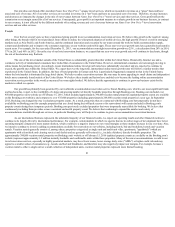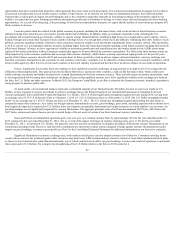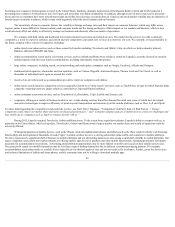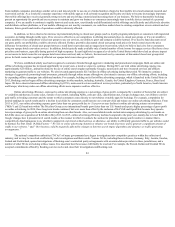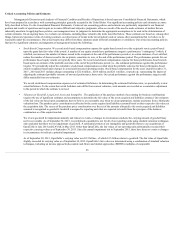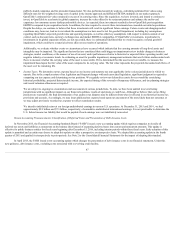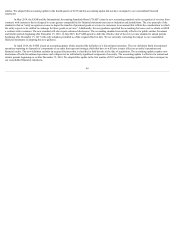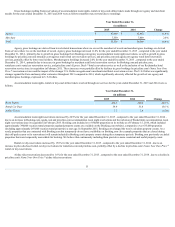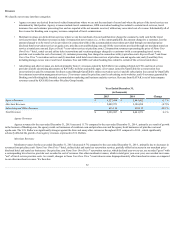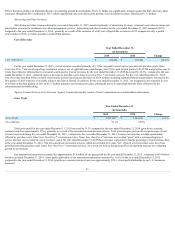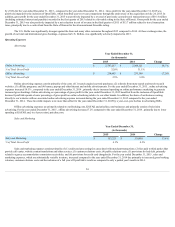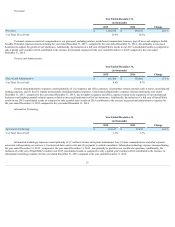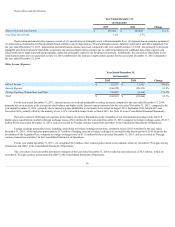Priceline 2015 Annual Report Download - page 50
Download and view the complete annual report
Please find page 50 of the 2015 Priceline annual report below. You can navigate through the pages in the report by either clicking on the pages listed below, or by using the keyword search tool below to find specific information within the annual report.
publicly-traded companies and for precedent transactions). We also performed sensitivity analysis, calculating estimated fair values using
different rates for the weighted-average cost of capital in the income approach and different EBITDA multiples in our market approach.
OpenTable’s estimated fair value remained in excess of its carrying value. Since the acquisition, we have invested, and intend to continue to
invest, in OpenTable to accelerate its global expansion, increase the value offered to its restaurant partners and enhance the end-to-end
experience for consumers across desktop and mobile devices. As expected, these investments resulted in lower OpenTable post-acquisition
EBITDA compared to pre-acquisition levels. In addition, the time required to execute these investments has exceeded our initial expectations.
Despite the delays, we continue to believe that these investments will result in significant future earnings. Future events and changing market
conditions may, however, lead us to reevaluate the assumptions we have used to test for goodwill impairment, including key assumptions
regarding OpenTable's expected growth rates and operating margins, as well as other key assumptions with respect to matters outside of our
control, such as discount rates, currency exchange rates and market EBITDA comparables. If OpenTable’s investments, in particular its
investments in its global expansion efforts, are not successful, there is a substantial likelihood that we would recognize a related goodwill
impairment, which could have a material adverse effect on our results of operations.
Additionally, we evaluate whether events or circumstances have occurred which indicate that the carrying amounts of long-lived assets and
intangibles may be impaired. The significant factors that are considered that could trigger an impairment review include changes in business
strategies, market conditions, or the manner of use of an asset; under performance relative to historical or expected future operating results; and
negative industry or economic trends. In evaluating an asset for possible impairment, management estimates that asset's future undiscounted cash
flows to measure whether the carrying value of the asset is recoverable. If it is determined that the asset is not recoverable, we measure the
impairment based upon the fair value of the asset compared to its carrying value. The fair value represents the projected discounted cash flows of
the asset over its remaining life.
•Income Taxes. We determine our tax expense based on our income and statutory tax rates applicable in the various jurisdictions in which we
operate. Due to the complex nature of tax legislation and frequent changes with such associated legislation, significant judgment is required in
computing our tax expense and determining our tax positions. We regularly review our deferred tax assets for recoverability considering
historical profitability, projected future taxable income, the expected timing of the reversals of temporary differences, and tax planning strategies
and record valuation allowances as required.
We are subject to ongoing tax examinations and assessments in various jurisdictions. To date, we have been audited in several taxing
jurisdictions with no significant impact on our financial condition, results of operations or cash flows. Although we believe that our tax filing
positions are reasonable, the final determination of tax audits or tax disputes may be different from what is reflected in our historical income tax
provisions and accruals. Accordingly, we may incur additional tax expense based upon our assessment of the more likely than not outcomes or
we may adjust previously recorded tax expense to reflect examination results.
We intend to indefinitely reinvest our foreign undistributed earnings in our non-U.S. operations. At December 31, 2015 and 2014 , we had
approximately $9.9 billion and $7.3 billion, respectively, of cumulative undistributed international earnings. It is not practicable to determine the
U.S. federal income tax liability that would be payable if such earnings were not indefinitely reinvested.
Recent Accounting Pronouncements: Classification of Deferred Taxes and Presentation of Debt Issuance Costs
In November 2015, the Financial Accounting Standards Board (“FASB”) issued a new accounting update which requires companies to classify all
deferred tax assets and liabilities as noncurrent on the balance sheet instead of separating deferred taxes into current and noncurrent amounts. This update is
effective for public business entities for fiscal years beginning after December 15, 2016, including interim periods within those fiscal years. Early adoption of this
update is permitted and an entity may choose to adopt this update on either a prospective or retrospective basis. We adopted this accounting update in the fourth
quarter of 2015 and applied it retrospectively to prior periods. See Note 2 to the Consolidated Financial Statements for the impact of adopting this standard.
In April 2015, the FASB issued a new accounting update which changes the presentation of debt issuance costs in our financial statements. Under this
new guidance, debt issuance costs, excluding costs associated with a revolving credit facility,
47


